Submitted:
20 February 2024
Posted:
21 February 2024
You are already at the latest version
Abstract
Keywords:
1. Introduction
2. Materials and Methods
2.1. Questionnaire and online survey tools development
2.2. Case definition of small-scale carp farmer
2.3. Study area and farm selection
2.4. Survey implementation
2.5. Data gathering, preparation and analysis
3. Results
3.1. Farmer profile: social and regional perspectives
3.2. Farm characteristics and practices
3.3. Disease incidence and pattern
3.4. Diseases management and treatment
3.5. Factors associated with disease incidence
3.6. Farmers’ observations regarding diseases.
4. Discussion
5. Conclusions
Supplementary Materials
Author Contributions
Data Availability Statement
Acknowledgments
Conflicts of Interest
References
- Food and Agriculture Organization of the United Nations (FAO). The State of World Fisheries and Aquaculture; FAO Fisheries and Aquaculture Department: Rome, Italy, 2012. [Google Scholar]
- INFOFISH. The small-scale fisheries and aquaculture sector in Asia – Small in scale, big in value; FAO: Bangkok, 2022. [Google Scholar]
- Chan, C. Y.; Tran, N.; Pethiyagoda, S.; Crissman, C. C.; Sulser, T. B.; Phillips, M. J. Prospects and challenges of fish for food security in Africa. Global Food Security 2019, 20, 17–25. [Google Scholar] [CrossRef]
- Food and Agriculture Organization of the United Nations (FAO). The State of World Fisheries and Aquaculture, 2020. Sustainability in Action; Rome, Italy, 2020. [Google Scholar]
- Deaprtment of Fisheries (DoF). National fish week 2022 compendium; Department of Fisheries, Bangladesh: Ministry of Fisheries and livestock, Bangladesh, 2022; Volume 160. [Google Scholar]
- Food and Agriculture Organization of the United Nations (FAO). The State of World Fisheries and Aquaculture 2022. Towards Blue Transformation; Rome, Italy, 2022. [Google Scholar]
- Hernandez, R.; Belton, B.; Reardon, T.; Hu, C.; Zhang, X.; Ahmed, A. The “quiet revolution” in the aquaculture value chain in Bangladesh. Aquaculture 2018, 493, 456–468. [Google Scholar] [CrossRef]
- Jahan, K. M.; Ahmed, M.; Belton, B. The impacts of aquaculture development on food security: Lessons from Bangladesh. Aquaculture Research 2010, 41, 481–495. [Google Scholar] [CrossRef]
- Siddiqa, A.; Haque, S. M.; Barman, B. K. Women’s participation in aquaculture in southwest Bangladesh. Asian Fisheries Science 2017, 30, 375–381. [Google Scholar] [CrossRef]
- Belton, B.; Thilsted, S. H. Fisheries in transition: Food and nutrition security implications for the global South. Global Food Security 2014, 3, 59–66. [Google Scholar] [CrossRef]
- Food and Agriculture Organization of the United Nations (FAO). Aquaculture development. 4. Ecosystem approach to aquaculture. FAO Technical Guidelines for Responsible Fisheries; Rome, Italy, 2010. [Google Scholar]
- Deaprtment of Fisheries (DoF). Yearbook of Fisheries Statistics of Bangladesh, 2018-19. Fisheries Resources Survey System (FRSS); Department of Fisheries, Bangladesh: Ministry of Fisheries and Livestock, 2019; Volume 36, p. 135. [Google Scholar]
- Faruk, M.; Alam, M.; M.M.R, S.; M.B, K. Status of Fish Disease and Health Management Practices in Rural Freshwater Aquaculture of Bangladesh. Pakistan Journal of Biological Sciences 2004, 7. [Google Scholar] [CrossRef]
- Uddin, S.; Islam, M.; Bhuyain, M.; Mannan, M.; Alam, M. Fish diseases and strategies taken by the farmers in freshwater aquaculture at southwestern Bangladesh. Bangladesh Journal of Zoology 2016, 44, 111. [Google Scholar] [CrossRef]
- Debnath, P. P.; Jansen, M. D.; Delamare-Deboutteville, J.; Mohan, C. V.; Dong, H. T.; Rodkhum, C. Is tilapia mortality a latent concern for the aquaculture sector of Bangladesh? An epidemiology and health economic impact study. Aquaculture 2022, 560, 738607. [Google Scholar] [CrossRef]
- Faruk, M. A. R.; Anka, I. Z. An overview of diseases in fish hatcheries and nurseries. Fundamental and Applied Agriculture 2017, 2, 311–316. [Google Scholar] [CrossRef]
- Deb, A.; Samanta Chandan, C. S.; Roy, P.; Hossain; Bari, S. Inland Aquaculture and Fish Health Management: A Case Study of Sylhet District in Bangladesh. Aquaculture Studies 2021, 21, 129–137. [Google Scholar] [CrossRef] [PubMed]
- Faruk, M. A. R.; Rahman, N.; Patwary, Z. P. Risk factors associated with tilapia and pangasius diseases. Journal of Bangladesh Agricultural University 2017, 15, 325–331. [Google Scholar] [CrossRef]
- Tran, K.; Verdegem, M.; Wolkenfelt, B.; Mohan, C.; Verreth, J. The relation between farming practices and tilapia production in small-scale fish farms in Bangladesh.; Penang, Malaysia: CGIAR Research Program on Fish Agri-Food Systems. Program Report: FISH-2019-06., 2019. [Google Scholar]
- Miura, T.; Iwata, K.; Zongshe, Z. Biological significance of effects of phytophagous fishes on phytoplankton. Chinese Journal of Oceanology and Limnology 1989, 7, 335–338. [Google Scholar] [CrossRef]
- Zhao, Z.; Luo, L.; Wang, C. a.; Li, J.; Wang, L.; Du, X.; Xu, Q. Effects of organic carbon addition on water quality and growth performance of bottom- and filter-feeding carp in a minimum-water-exchange pond polyculture system. Fisheries Science 2018, 84, 681–689. [Google Scholar] [CrossRef]
- Pulkkinen, K.; Suomalainen, L. R.; Read, A. F.; Ebert, D.; Rintamäki, P.; Valtonen, E. T. Intensive fish farming and the evolution of pathogen virulence: the case of columnaris disease in Finland. Proceedings Biological sciences 2010, 277, 593–600. [Google Scholar] [CrossRef] [PubMed]
- Wakabayashi, H. Recent Fish Disease Problems in Japan. Aquaculture Science 1996, 44, 377–381. [Google Scholar] [CrossRef]
- Jahan, K. M.; Belton, B.; Ali, H.; Dhar, G. C.; Ara, I. Aquaculture Technologies in Bangladesh: An Assessment of Technical and Economic Performance and Producer Behavior. Working Paper 2015, 52, 1–95. [Google Scholar]
- MacKinnon, B.; Debnath, P. P.; Bondad-Reantaso, M. G.; Fridman, S.; Bin, H.; Nekouei, O. Improving tilapia biosecurity through a value chain approach. Reviews in Aquaculture 2023, 15, 57–91. [Google Scholar] [CrossRef]
- Boyd, C. E.; Drying, liming, other treatments disinfect pond bottoms. Seafood Alliance. 2012. Available online: https://www.globalseafood.org/advocate/drying-liming-other-treatments-disinfectpond-bottoms/ (accessed on 2 November 2012).
- Samanta, C. S.; Roy, P. Aquaculture practices in Bangladesh: A synopsis on prospects, productivity, and problems. Journal of the World Aquaculture Society 2023, Review. [Google Scholar] [CrossRef]
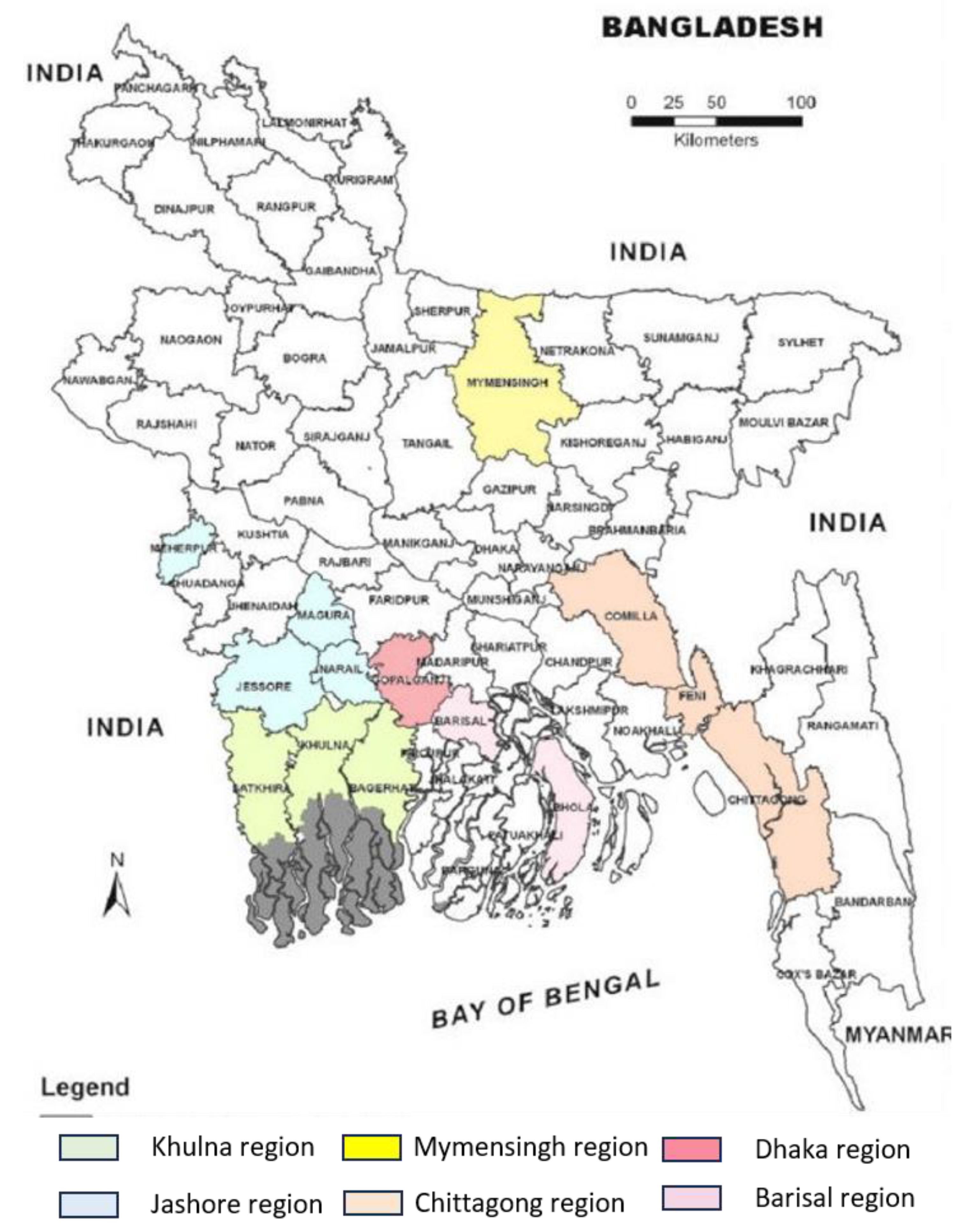
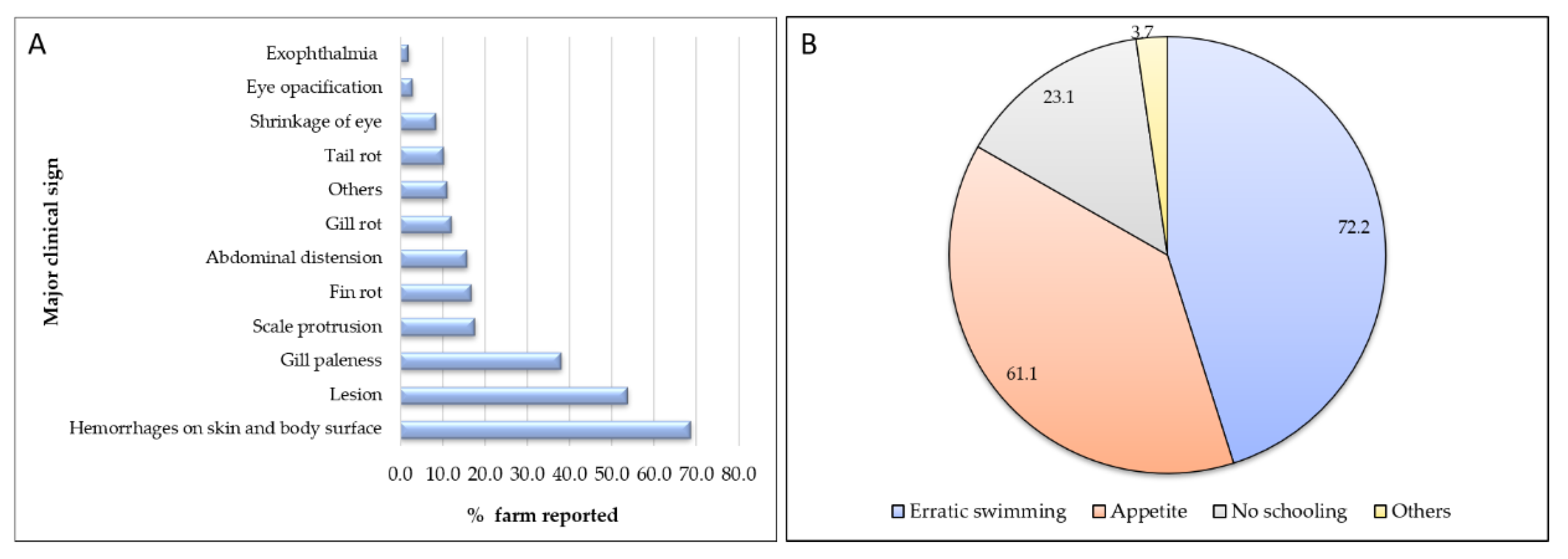
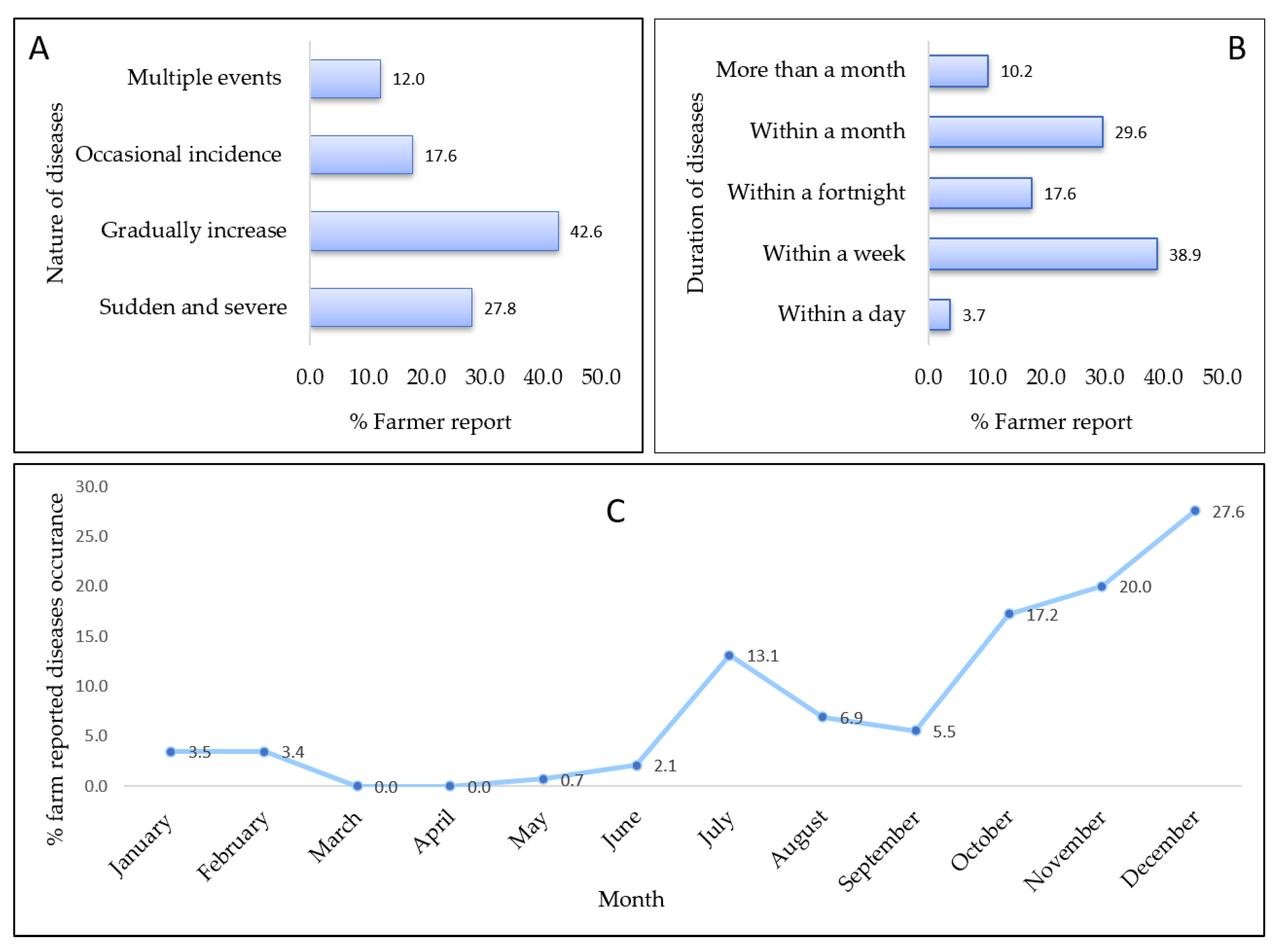
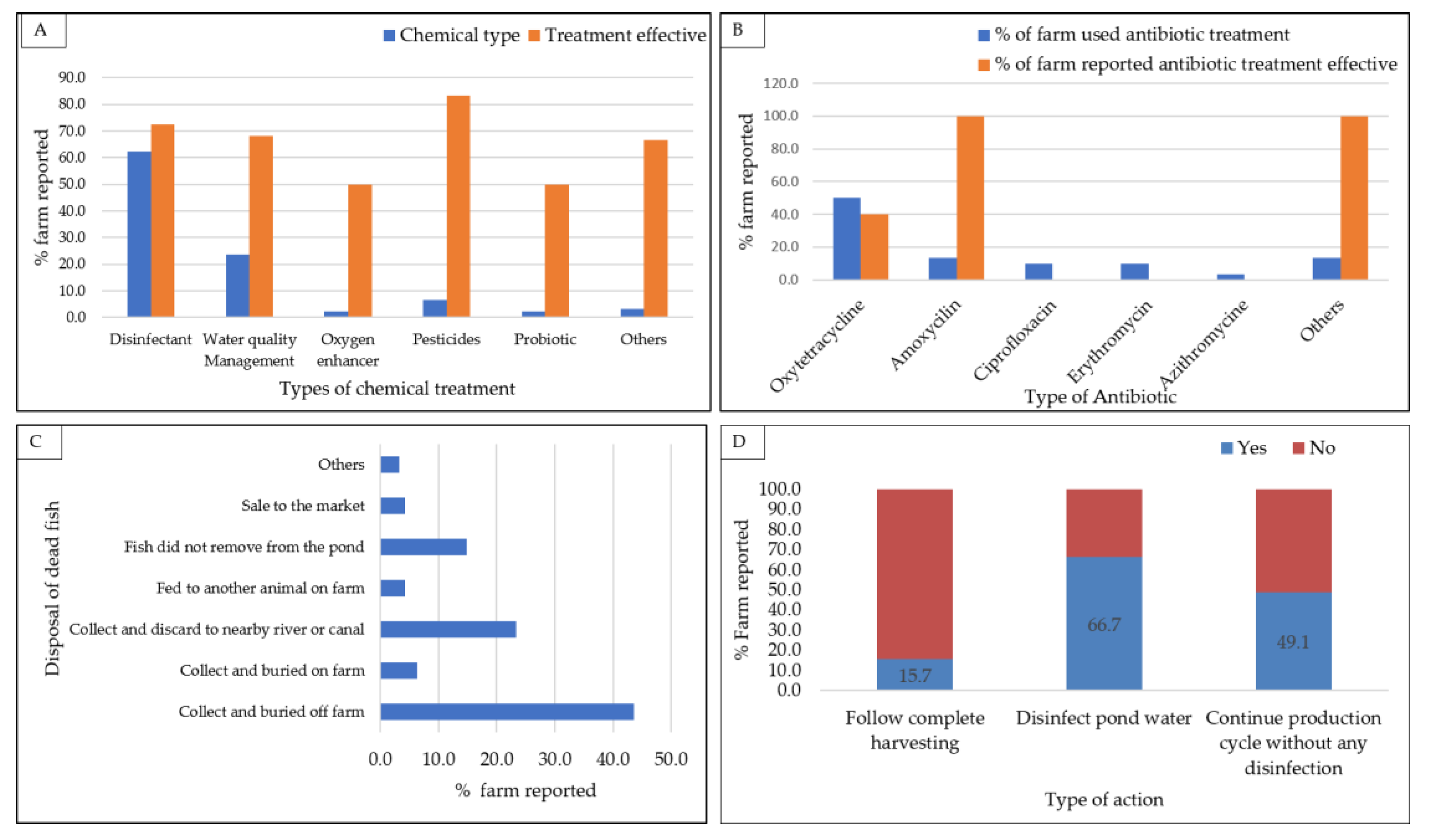
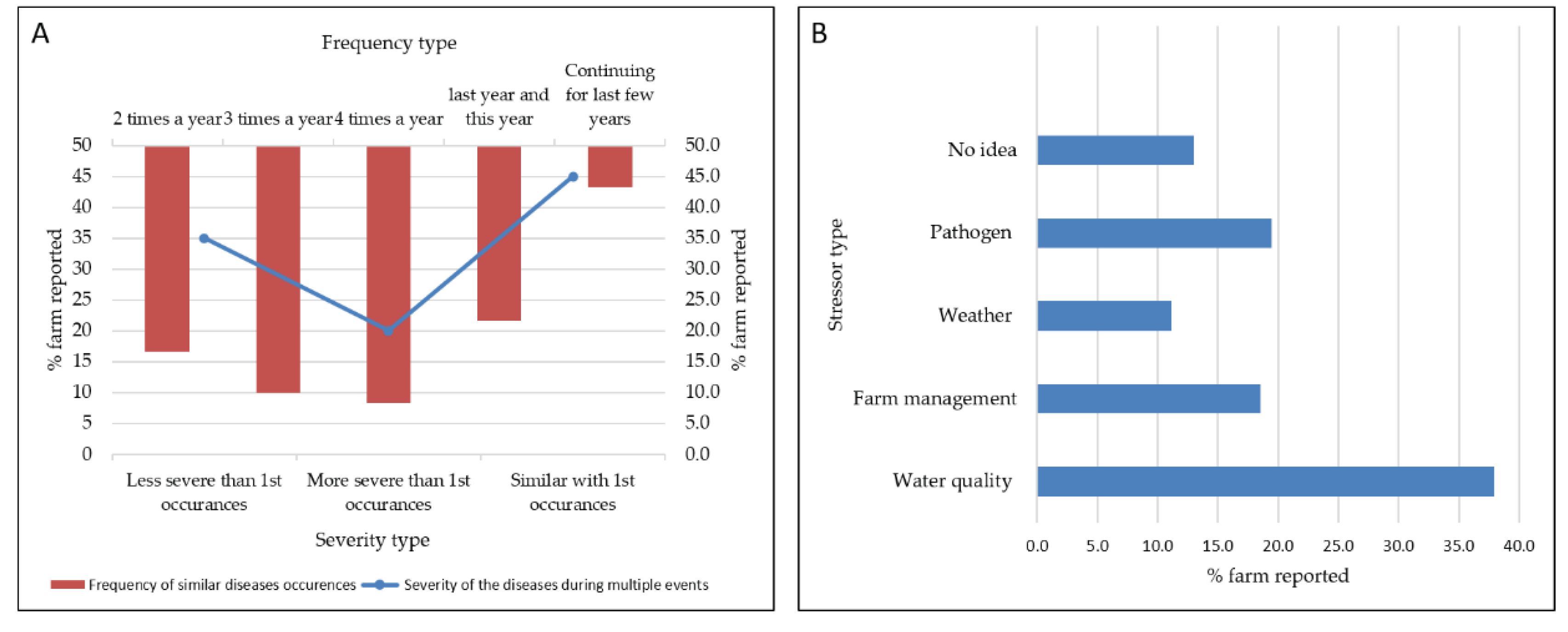
| Characteristics | Region (Number of farms studied) | ||||||
|---|---|---|---|---|---|---|---|
| Barishal (65) | Chittagong (24) | Dhaka (18) | Khulna (44) | Mymenshingh (21) | Jashore (58) |
||
| n (%) or mean (min, max) | p | ||||||
| Farmer age (Years) | 46.0 (25-75) | 50.8 (30-65) | 42.2 (24-65) | 41.5 (23-65) | 42.2 (29-65) | 46.2 (30-70) | 0.008 |
| Farmer education level | |||||||
| No education | 10 (15.2) | 3 (12.5) | 6 (33.3) | 5(11.4) | 4 (19.0) | 7 (12.1) | 0.008 |
| Primary (1-5) | 21 (31.8) | 9 (37.5) | 1 (5.6) | 4 (9.1) | 3 (14.3) | 6 (10.3) | |
| Higher Secondary (6-12) | 28 (42.4) | 11 (45.8) | 8 (44.4) | 26 (59.1) | 11 (52.4) | 33 (56.9) | |
| University (Bachelor/MS/more) | 7 (10.6) | 1 (4.2) | 3 (16.7) | 9 (20.5) | 3 (14.3) | 12 (20.7) | |
| Primary occupation | |||||||
| Agriculture | 10 (15.2) | 9 (37.5) | 1 (5.6) | 5 (11.4) | 0 (0.0) | 1 (1.7) | 0.729 |
| Aquaculture | 37 (56.1) | 3 (12.5) | 16 (88.9) | 33 (75.0) | 16 (76.2) | 39 (67.2) | |
| Business | 6 (9.1) | 7 (29.2) | 1 (5.6) | 2 (4.5) | 4 (19.0) | 10 (17.2) | |
| Job/Service | 12 (18.2) | 4 (16.7) | 0 (0.0) | 3 (6.8) | 1 (4.8) | 7 (12.1) | |
| Others | 1 (1.5) | 1 (4.2) | 0 (0.0) | 1 (2.3) | 0 (0.0) | 1 (1.7) | |
| Secondary occupation | |||||||
| No secondary occupation | 4 (6.1) | 0 (0.0) | 2 (11.1) | 4 (9.1) | 3 (14.3) | 3 (5.2) | 0.428 |
| Agriculture | 9 (13.6) | 0 (0.0) | 4 (22.2) | 13 (29.5) | 4 (19.0) | 20 (34.5) | |
| Aquaculture | 29 (43.9) | 21 (87.5) | 2 (11.1) | 11 (25.0) | 5 (23.8) | 19 (32.8) | |
| Business | 19 (28.8) | 3 (12.5) | 4 (22.2) | 10 (22.7) | 6 (28.6) | 10 (17.2) | |
| Job | 2 (3.0) | 0 (0.0) | 1 (5.6) | 0 (0.0) | 0 (0.0) | 0 (0.0) | |
| Others | 3 (4.5) | 0 (0.0) | 5 (27.8) | 6 (13.6) | 3 (14.3) | 6 (10.3) | |
| Farming experiences (Years) | |||||||
| 1-5 years | 9 (34.6) | 0 (0.0) | 3 (11.5) | 8 (30.8) | 3 (11.5) | 3 (11.5) | 0.004 |
| 6-10 years | 24 (35.3) | 2 (2.9) | 6 (8.8) | 14 (20.6) | 7 (10.3) | 15 (22.1) | |
| 11-15 years | 15 (29.4) | 3 (5.9) | 3 (5.9) | 10 (19.6) | 5 (9.8) | 15 (29.4) | |
| 16-20 years | 14 (35.0) | 5 (12.5) | 2 (5.0) | 6 (15.0) | 3 (7.5) | 10 (25.0) | |
| Above 20 years | 4 (8.7) | 14(30.4) | 4 (8.7) | 6 (13.0) | 3 (6.5) | 15 (32.6) | |
| Total Farm area (Ha) | 0.54 (0.03-1.82) | 0.77 (0.13-1.62) | 0.58 (0.26-1.01) | 0.67 (0.03-2.00) | 0.79 (0.08-1.27) | 0.83 (0.08-1.68) | 0.001 |
| Total water spread area (Ha) | 0.44 (0.02-1.62) | 0.65 (0.01-1.38) | 0.46 (0.18-0.81) | 0.55 (0.02-1.74) | 0.63 (0.07-1.05) | 0.65 (0.06-1.47) | 0.001 |
| Number of ponds in farm | 3 (1-10) | 3 (1-13) | 2 (1-5) | 2 (1-7) | 3 (1-6) | 2 (1-4) | <0.001 |
| Farm type | |||||||
| Perennial | 63 (95.5) | 24 (100) | 18 (100) | 43 (97.7) | 21 (100) | 58(100) | 0.096 |
| Seasonal | 3 (4.5) | 0 (0.0) | 0 (0.0) | 1 (2.3) | 0 (0.0) | 0 (0.0) | |
| Water Sources | |||||||
| Ground water | 7 (10.6) | 24 (100.0) | 2 (11.1) | 18 (40.9) | 20 (95.2) | 48 (82.8) | <0.001 |
| River/canal | 52 (78.8) | 0 (0.0) | 12 (66.7) | 22 (50.0) | 0 (0.0) | 3 (5.2) | |
| Rain | 1 (1.5) | 0 (0.0) | 2 (11.1) | 1 (2.3) | 0 (0.0) | 5 (8.6) | |
| Ground water+River/canal | 6 (9.1) | 0 (0.0) | 0 (0.0) | 0 (0.0) | 1 (4.8) | 2 (3.4) | |
| Rain+Nearby farm | 0 (0.0) | 0 (0.0) | 2 (11.1) | 3 (6.8) | 0 (0.0) | 0 (0.0) | |
| Stocking Species | |||||||
| Carp | 0 (0.0) | 0 (2.6) | 1 (5.6) | 2 (4.5) | 1 (4.8) | 11 (19.0) | 0.673 |
| Carp+Tilapia | 10 (15.2) | 12 (50.0) | 5 (27.8) | 12 (27.3) | 1 (4.8) | 26 (44.8) | |
| Carp+Tilapia+Other freshwater species | 36 (54.5) | 12 (50.0) | 12 (66.7) | 15 (34.1) | 8 (38.1) | 5 (8.6) | |
| Carp+Tilapia+Freshwater species+Brackishwater species | 19 (28.8) | 0 (0.0) | 0 (0.0) | 9 (20.5) | 0 (0.0) | 0 (0.0) | |
| Carp+other freshwater species | 1 (1.5) | 0 (0.0) | 0 (0.0) | 6 (13.6) | 11 (52.4) | 16 (27.6) | |
| Source of fingerlings | |||||||
| Hatchery | 29 (43.9) | 9 (37.5) | 8 (44.4) | 10 (22.7) | 6 (28.6) | 25 (43.1) | 0.504 |
| Nursery | 8 (12.1) | 0 (0.0) | 7 (38.9) | 5 (11.4) | 4 (19.0) | 3 (5.2) | |
| Hatchery+nursery | 11 (16.7) | 15 62.5) | 3 (16.7) | 16 (36.4) | 11 (52.4) | 20(34.5) | |
| Hatchery+incoming water | 17 (25.8) | 0 (0.0) | 0 (0.0) | 10 (22.7) | 0 (0.0) | 5 (8.6) | |
| Others | 1 (1.5) | 0 (0.0) | 0 (0.0) | 3 (6.8) | 0 (0.0) | 5 (8.6) | |
| Stocking density (Number/Ha) | 97810 (2059 - 1235500) | 39495 (5343 - 98840) | 111239 (15444 - 329467) | 105912 (6919 -1445168) | 366756 (3802 -1728635) | 60212 (3756 - 658933) | <0.001 |
| Average % of Carp stocked) | 39.5 (20-85) | 60.1 (20 - 95) | 37.9 (24 - 100) | 38.8 (20 -100) | 38.1 (25 - 100) | 56.6 (20-100) | <0.001 |
| All farms | Reported diseases | |||
|---|---|---|---|---|
| N = 281 | No (N = 136) | Yes (N = 145) | ||
| Variables | n (%) or mean (min, max) | n (%) or mean (95% CI) | P | |
| Region | ||||
| Barishal | 66 (28.6) | 24 (36.4) | 42 (63.6) | <0.001 |
| Chittagong | 24 (10.4) | 1 (4.2) | 23 (95.8) | |
| Dhaka | 18 (7.8) | 9 (50.0) | 9 (50.0) | |
| Khulna | 44 (19.0) | 34 (77.3) | 10 (22.7) | |
| Mymensingh | 21 (9.1) | 16 (76.2) | 5 (23.8) | |
| Jashore | 58 (25.1) | 39 (67.2) | 19 (32.8) | |
| Farmer age | 45 (23-75) | 44 (23-75) | 46 (24-65) | 0.069 |
| Education | ||||
| No education | 35 (15.2) | 21 (60.0) | 14 (40.0) | 0.76 |
| Primary (1-5) | 44(19.0) | 22 (50.0) | 22 (50.0) | |
| Higher secondary (6-12) | 117 (50.6) | 60 (51.3) | 57 (48.7) | |
| University degree | 35 (15.2) | 20 (57.1) | 15 (42.9) | |
| Primary occupation | ||||
| Agriculture | 26 (11.3) | 6 (23.1) | 20 (76.9) | <0.001 |
| Aquaculture | 144 (62.3) | 91 (63.2) | 53 (36.8) | |
| Business | 30 (13.0) | 14 (46.7) | 16 (53.3) | |
| Job | 27 (11.7) | 10 (37.0) | 17 (63.0) | |
| Others | 4 (1.7) | 2 (50.0) | 2 (50.0) | |
| Farming experiences | 15 (1-40) | 13 (1-40) | 16 (2-40) | 0.003 |
| 1-5 years | 26 (11.3) | 20 (76.9) | 6 (23.1) | 0.036 |
| 6-10 years | 68 (29.4) | 40 (58.8) | 28 (41.2) | |
| 11-15 years | 51 (22.1) | 25 (49.0) | 26 (51.0) | |
| 16-20 years | 40 (17.3) | 19 (47.5) | 21 (52.5) | |
| Above 20 years | 46 (19.9) | 19 (41.3) | 27 (58.7) | |
| Farm area (Ha) | 0.69 (0.03-2.0) | 0.65 (0.03-1.82) | 0.73 (0.08-2.00) | 0.211 |
| Nos of pond/farm | 2 (1-13) | 2 (1-7) | 3 (1-13) | <0.001 |
| Source of water | ||||
| Ground water | 119 (51.5) | 69 (58.0) | 50 (42.0) | 0.06 |
| River/canal | 89 (38.5) | 41 (46.1) | 48 (53.9) | |
| Rain | 9 (3.9) | 5 (55.6) | 4 (44.4) | |
| Ground water+River/canal | 9 (3.9) | 3 (33.3) | 6 (66.7) | |
| Rain+Nearby farm | 5 (2.2) | 5 (100.0) | 0 (0.0) | |
| Species stocked | ||||
| Carp species | 15 (6.5) | 11 (73.3) | 4 (26.7) | <0.001 |
| Carp+Tilapia | 66 (28.6) | 29 (43.9) | 37 (56.1) | |
| Carp+Tilapia+Other freshwater species | 88 (38.1) | 54 (61.4) | 34 (38.6) | |
| Carp+Tilapia+Freshwater species+Brackishwater species | 28 (12.1) | 6 (21.4) | 22 (78.6) | |
| Carp+other freshwater species | 34 (14.7) | 23 (67.6) | 11 (32.4) | |
| Fingerling sources | ||||
| Hatchery | 87 (37.7) | 45 (51.7) | 42 (48.3) | 0.038 |
| Nursery | 27 (11.7) | 17 (63.0) | 10 (37.0) | |
| Hatchery+nursery | 76 (32.9) | 44 (57.9) | 32 (42.1) | |
| Hatchery+incoming water | 32 (13.9) | 10 (31.3) | 22 (68.8) | |
| Others | 9 (3.9) | 7 (77.8) | 2 (22.2) | |
| Stocking density | 109351 (2059-1728635) | 134803 (3756-1445168) | 80364 (2059-1728635) | 0.057 |
| Carp % of total stocking | 45.6 (20-100) | 42.2 (20-100) | 49.4 (20-100) | 0.049 |
| Variables | All farms | Reported diseases | ||
|---|---|---|---|---|
| N = 231 | No (N = 123) | Yes (N = 108) | ||
| n (%) or mean (min, max) | n (%) or mean (95% CI) | P | ||
| Biosecurity management during pond preparation | ||||
| Fallow period | ||||
| No fallow period | 23 (10.0) | 18 (78.3) | 5 (21.7) | 0.069 |
| one week | 30 (13.0) | 14 (46.7) | 16 (53.3) | |
| Fortnight | 50 (21.6) | 25 (50.0) | 25 (50.0) | |
| One Month | 56 (24.2) | 25 (44.6) | 31 (555.4) | |
| More than one month | 72 (31.2) | 41 (56.9) | 31 (43.1) | |
| Pond preparation | ||||
| Bleaching+Pond bottom drying+Liming | 10 (4.3) | 10 (100) | 0 (0.0) | <0.001 |
| Pond bottom drying+ploughing+Liming | 25 (10.8) | 19 (76.0) | 6 (24.0) | |
| Pond bottom drying+Liming | 135 (58.4) | 55 (40.7) | 80 (59.3) | |
| Liming | 58 (25.1) | 37 (63.8) | 21 (36.2) | |
| No measures | 3 (1.3) | 2 (66.7) | 1 (33.3) | |
| Biosecurity management followed during stocking | ||||
| Biosecurity practices at stocking | ||||
| Fish transport water discarded off farm+Fish disinfection+Fish health Inspection | 33 (14.3) | 21 (63.6) | 12 (36.4) | 0.010 |
| Fish transport water discarded off farm+Fish health Inspection | 70 (30.3) | 26 (37.1) | 44 (62.9) | |
| Fish Disinfection+Fish health Inspection | 12 (5.2) | 6 (50.0) | 6 (50.0) | |
| Fish transport water discarded off farm+Fish disinfection | 9 (3.9) | 7(77.80 | 2 (22.2) | |
| Fish Disinfection | 17 (7.4) | 8 (47.1) | 9 (52.9) | |
| Fish health inspection | 22 (9.5) | 9 (40.9) | 13 (59.1) | |
| Fish transport water discarded off farm | 21 (9.1) | 15 (71.4) | 6 (28.6) | |
| No action taken | 47 (20.3) | 31 (66.0) | 16 (34.0) | |
| Introduction of new stock with old stock | ||||
| Yes | 157 (68) | 94 (59.9) | 63 (40.1) | 0.005 |
| No | 74 (32) | 29 (39.2) | 45 (60.8) | |
| On Farm general biosecurity Management | ||||
| Farm perimeter fence | ||||
| Yes | 79 (34.2) | 39 (49.4) | 40 (50.6) | 0.408 |
| No | 152 (65.8) | 84 (55.3) | 68 (44.7) | |
| Restriction of entrance for general people | ||||
| Yes | 31 (13.4) | 19 (61.3) | 12 (38.7) | 0.440 |
| No | 200 (86.6) | 104 (52.0) | 96 (48.0) | |
| Restriction of entrance for domestic or other animals | ||||
| Yes | 54 (23.4) | 39 (72.2) | 15 (27.8) | 0.002 |
| No | 177 (76.6) | 84 (47.5) | 93 (52.5) | |
| Shared equipment with other farm/s | ||||
| Yes | 155 (67.1) | 82 (52.9) | 73 (47.1) | 0.889 |
| No | 76 (32.9) | 41 (53.9) | 35 (46.1) | |
| Hired harvester | ||||
| Yes | 223 (96.5) | 120 (53.8) | 103 (46.2) | 0.479 |
| No | 8 (3.5) | 3 (37.5) | 5 (62.5) | |
| Hired harvesting equipment | ||||
| Yes | 223 (96.5) | 119 (53.4) | 104 (46.6) | 0.565 |
| No | 8 (3.5) | 4 (50.0) | 4 (50.0) | |
| Variables | (OR) | 95% CI | p-value | AIC |
|---|---|---|---|---|
| Region | 275.37 | |||
| Barishal | 1 | <0.001 | ||
| Chittagong | 0.0761 | 0.0097-0.5994 | ||
| Dhaka | 1.75 | 0.6116-5.0074 | ||
| Khulna | 5.95 | 2.5046-14.1350 | ||
| Mymensingh | 5.6 | 1.8226-17.2057 | ||
| Jashore | 3.5921 | 1.7085-7.5523 | ||
| Primary occupation | 310.16 | |||
| Agriculture | 1 | <0.001 | ||
| Aquaculture | 5.7233 | 2.1627-15.1455 | ||
| Business | 2.9167 | 0.9138-9.3090 | ||
| Job | 1.9608 | 0.59-6.5168 | ||
| Others | 3.3333 | 0.3837-28.9537 | ||
| Farming experiences | 314.97 | |||
| 1-5 years | 1 | 0.003 | ||
| 6-10 years | 0.429 | 0.153-1.203 | ||
| 11-15 years | 0.288 | 0.099-0.837 | ||
| 16-20 years | 0.271 | 0.09-0.818 | ||
| Above 20 years | 0.211 | 0.071-0.625 | ||
| Nos of pond/farm | <0.001 | 309.68 | ||
| 0-5 | 1 | |||
| 6-10 | 0.2782 | 0.55-1.4088 | ||
| 11-15 | 0 | Undefine | ||
| Species stocked | 307.23 | |||
| Carp species | 1 | <0.001 | ||
| Carp+Tilapia | 0.285 | 0.0822-0.9882 | ||
| Carp+Tilapia+Other freshwater species | 0.5775 | 0.1701-1.9605 | ||
| Carp+Tilapia+Freshwater species+Brackishwater species | 0.0992 | 0.0231-0.4260 | ||
| Carp+other freshwater species | 0.7603 | 0.1969-2.9366 | ||
| Fingerling sources | 318.84 | |||
| Hatchery | 1.5867 | 0.6535-3.8526 | 0.038 | |
| Nursery | 1.2833 | 0.6905-2.3852 | ||
| Hatchery+nursery | 0.4242 | 0.1799-1.0002 | ||
| Hatchery+incoming water | 3.2667 | 0.6421-16.6192 | ||
| Others | ||||
| Carp % of total stocking | 0.049 | 317.55 | ||
| 0-35 | 1 | |||
| 36-70 | 0.233 | 0.1281-0.4238 | ||
| 71-100 | 0.576 | 0.2567-1.2927 | ||
| Biosecurity measures during pond preparation | 299.8 | |||
| Bleaching+Pond bottom drying+Liming | 0 | Undefine | <0.001 | |
| Pond bottom drying+ploughing+Liming | 0 | Undefine | ||
| Pond bottom drying+Liming | 0 | Undefine | ||
| Liming | 0 | Undefine | ||
| No measures | 0 | Undefine | ||
| Biosecurity practices at stocking | 316.48 | |||
| Fish transport water discarded off farm+Fish disinfection+Fish health Inspection | 1 | 0.01 | ||
| Fish transport water discarded off farm+Fish health Inspection | 0.3377 | 0.1430-0.7973 | ||
| Fish Disinfection+Fish health Inspection | 0.5714 | 0.1503-2.1725 | ||
| Fish transport water discarded off farm+Fish disinfection | 2 | 0.3567-11.2154 | ||
| Fish Disinfection | 0.5079 | 0.1549-1.6654 | ||
| Fish health inspection | 0.3956 | 0.1308-1.1968 | ||
| Fish transport water discarded off farm | 1.4286 | 0.4377-4.6630 | ||
| No action taken | 1.1071 | 0.4363-2.8094 | ||
| Introduction of new stock with old stock | 0.4319 | 0.2454-0.7602 | 0.005 | 314.59 |
| Restriction of entrance for domestic or other animals | 0.3474 | 0.1787-0.6752 | 0.002 | 312.73 |
| Multivariable, final model | Estimate | Std. error | z value | Pr (>|z|) | Significant level1 | AIC |
|---|---|---|---|---|---|---|
| (Intercept) | -1.79E+01 | 1.12E+03 | -0.016 | 0.987252 | 243.39 | |
| Region: Chittagong | 2.18E+00 | 1.16E+00 | 1.872 | 0.061192 | ||
| Region: Dhaka | 5.32E-03 | 6.65E-01 | 0.008 | 0.993615 | ||
| Region: Jashore | -1.74E+00 | 6.34E-01 | -2.747 | 0.006009 | ** | |
| Region: Khulna | -2.73E+00 | 7.01E-01 | -3.901 | 9.59E-05 | *** | |
| Region: Mymensingh | -1.88E+00 | 7.71E-01 | -2.437 | 0.014816 | * | |
| Farming Experiences (yr.) | 4.87E-02 | 2.48E-02 | 1.961 | 0.04988 | * | |
| Stocking spp: Carp+Other freshwater spp. | 2.28E+00 | 1.01E+00 | 2.259 | 0.023856 | * | |
| Stocking spp: Carp+Tilapia | 2.37E+00 | 9.47E-01 | 2.505 | 0.012242 | * | |
| Stocking spp: Carp+Tilapia+ Freshwater spp.+Brackishwater spp. | 4.58E+00 | 1.33E+00 | 3.453 | 0.000554 | *** | |
| Stocking spp: Carp+Tilapia+Other freshwater spp. | 8.63E-01 | 1.03E+00 | 0.845 | 0.397954 | ||
| Avg. Percentage of Carp Stocked | 2.85E-02 | 1.18E-02 | 2.413 | 0.015838 | * | |
| Pond Prep. Biosecurity: Liming | 1.62E+01 | 1.12E+03 | 0.014 | 0.988446 | ||
| Pond Prep. Biosecurity: No action | 1.50E+01 | 1.12E+03 | 0.013 | 0.989279 | ||
| Pond Prep. Biosecurity:Drying+Liming | 1.72E+01 | 1.12E+03 | 0.015 | 0.98772 | ||
| Pond Prep. Biosecurity:Drying+Liming+Plowing | 1.62E+01 | 1.12E+03 | 0.014 | 0.98847 | ||
| Biosecurity at Stocking: Fish disinfection+Fish health inspection | -9.73E-01 | 9.84E-01 | -0.989 | 0.322713 | ||
| Biosecurity at Stocking: Fish health inspection | -9.50E-01 | 8.57E-01 | -1.109 | 0.267501 | ||
| Biosecurity at Stocking: Transport water discarded off farm | -1.23E+00 | 8.70E-01 | -1.415 | 0.156963 | ||
| Biosecurity at Stocking: Transport water discarded off farm+Fish disinfection | -2.57E+00 | 1.11E+00 | -2.307 | 0.021028 | * | |
| Biosecurity at Stocking: Transport water discarded off farm+Fish disinfection+Fish health inspection | -2.67E+00 | 8.63E-01 | -3.092 | 0.001987 | ** | |
| Biosecurity at Stocking: Transport water discarded off farm | -1.83E+00 | 7.80E-01 | -2.35 | 0.018794 | * | |
| Biosecurity at Stocking: No action | -2.07E+00 | 7.81E-01 | -2.65 | 0.008049 | ** | |
| Restriction of entrance for domestic or other animals | -3.78E-01 | 4.30E-01 | -0.88 | 0.378658 |
Disclaimer/Publisher’s Note: The statements, opinions and data contained in all publications are solely those of the individual author(s) and contributor(s) and not of MDPI and/or the editor(s). MDPI and/or the editor(s) disclaim responsibility for any injury to people or property resulting from any ideas, methods, instructions or products referred to in the content. |
© 2024 by the authors. Licensee MDPI, Basel, Switzerland. This article is an open access article distributed under the terms and conditions of the Creative Commons Attribution (CC BY) license (http://creativecommons.org/licenses/by/4.0/).





